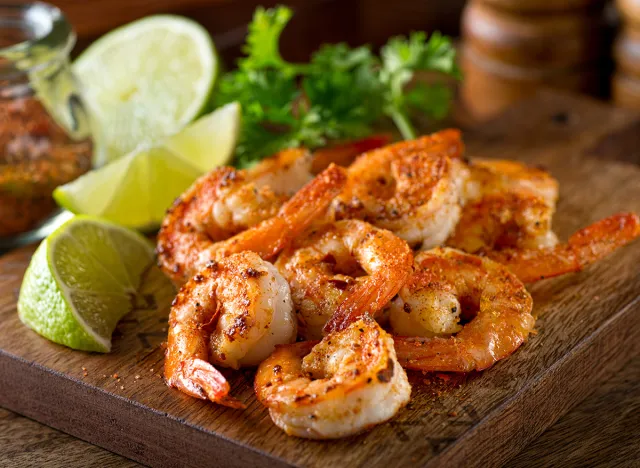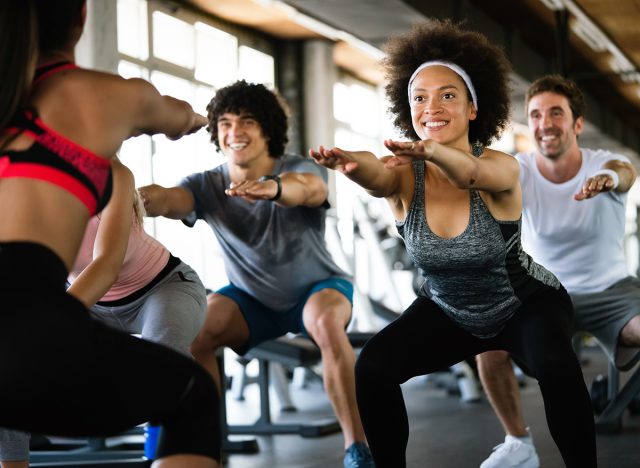How to Lose 15 Pounds of Fat in 3 Weeks, According to Weight Loss Expert

TikTok influencer @ImprovingwithKarla knows a thing or two about healthy, sustainable ways to lose fat—and she's got some tips on how to lose 15 pounds of fat in 3 months. Now, obviously, fat loss is not a linear process, and the more fat there is to lose, the faster it might go. Having said that, Karla has some sensible and doable tips on how to burn off fat in a safe manner. As with any change in routine, have a chat with your doctor to make sure it's right for you. Read on for Karla's top fat-burning tips!
All the Protein For Breakfast

Karla recommends a protein-packed breakfast to start the day. "I do roasted beef with shrimp and eggs," she says, clearly preferring animal-based protein sources. Whatever your choice of protein, research shows it's better to have it earlier in the day than, say, for a late dinner. "A high protein breakfast has been shown to benefit muscle health and to support weight loss by increasing muscle mass, energy expenditure (calories burned), satiety hormones, glucose regulation and by decreasing the desire to snack at night," Aubree Hawley, Ph.D., tells the American Society For Nutrition.
3 Liters Of Water Every Day

Karla drinks three liters of water every day to stay hydrated and energized. There is no one-size-fits-all amount of water that works for every single person, but a good rule of thumb is to pay attention to urine color. "It's best to go by the color of your urine," internist and board-certified physician nutrition specialist Melina Jampolis tells Johns Hopkins. "If it's dark yellow, you aren't drinking enough. Aim for light yellow."
Related: Cass Martin in Crop Top Shares Leg Day Routine
Lots of Sleep

Karla is in bed by ten p.m. for optimum rest and healing. "Allow your muscles and body to rest, having a good night's sleep will help with healing and you will feel energized," Karla writes in her post. Research shows poor sleep can lead to weight gain. "People might also feel more alert, energized, and happier with more sleep," Dr. Beth Frates, director of lifestyle medicine and wellness in the department of surgery at Massachusetts General Hospital tells Harvard Health. "This could lead to more activity, even if it isn't exercise. It may lead to less sitting and more socializing."
No Screens At Bedtime

Karla makes a good point about the impact screen time has on rest and relaxation before sleep. "Passive" technology such as music or a calming TV show is better, experts say, instead of something you engage with. "Checking your phone stimulates your brain," sleep expert Michelle Drerup, PsyD, DBSM, tells the Cleveland Clinic. "You're more active and awake. Even just a quick check can engage your brain and delay sleep."
Make Friends With the Gym

If you're intimidated by the gym and not sure how to use the equipment, Karla recommends starting with basic cardio sessions first just to familiarize yourself with the environment. This is great advice! "You can slowly start weightlifting after a month," she recommends, advising strength training five times a week and cardio three times a week.
Related: Fastest Way to Lose 30 Pounds, According to a TikTok Influencer
Now Mix It Up!

Karla's recommendation to mix up cardio and weight training is a good one. "The best way to burn fat is to have a longer aerobic activity with intervals of high intensity sprinting so that your heart rate reaches 70 to 80% of its maximum several times during your aerobic activity," says James Kojian, MD. This is also referred to as HIIT training, high intensity training sprinkled into your workout every 5 to 10 minutes. This will get you into the fat burning zone as well."
💪🔥Body Booster: Protein for breakfast will positively impact your entire day!




